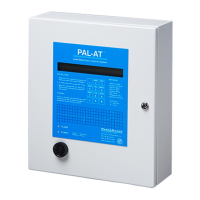PAL-AT Installation Manual
42
7 Cable Installation for Raised Floor and Ceilings
7.1 General
The PAL-AT sensor cables can be installed in ceilings above drop ceilings or on subfloors below raised
flooring to detect water, hydrocarbons, or chemical liquids. AGT-Gold responds quickly to thin films of
liquid. AGW-Gold allows a small accumulation before detecting a leak and dries quickly after removal of
the liquid. AGW-Gold was tested and passed UL910 for Plenum applications. AGW-Gold is the preferred
selection unless the application requires wicking of the liquid for detection of small liquid leakage.
The AGT-Gold sensor cable has a polypropylene yarn dielectric and is designed to absorb liquids readily
and detect leaks quickly. It also absorbs moisture from the air if the air is saturated or near saturation.
PermAlert recommends a maximum of 80% relative humidity, keeping in mind the relative humidity will
increase if the temperature of the air or a surface in the airflow decreases. In subfloor applications, care
must be taken to make sure the cable is not located directly in the airflow where localized higher humidity
or saturated air is present.
If the humidity level cannot be controlled and intermittent high humidity conditions exist, then the best
option is to use the quick-drying AGW-Gold cable in place of the wicking AGT-Gold cable.
7.2 Install the Sensor Cable
1. After all other work is completed and the area is free and clear of all activities that can cause damage,
the sensor cable should be installed. Care must be taken during installation of the sensor cable to
avoid contact with potential contaminants, such as water puddles or oil.
2. When the construction schedule allows, the PAL-AT panel should be permanently mounted and
connected with electrical power before installing jumper or sensor cable. This will allow the system's
setup and calibration procedures to proceed efficiently. For additional information on calibration points,
refer to the PAL-AT Operating Manual.
3. Slowly play out the cable by hand rotating the spool. Never pull loose coils of cable off the end of the
spool. When loose coils are pulled taut, kinks form in the cable that could prevent bringing the system
on-line. Keep the cable dry and clean.
4. Starting from the PAL-AT panel, connect a minimum of 50' [15 m] of JMP-UD jumper cable (65' [20 m]
for type JPP) before connecting the sensor cable. Route the sensor cable as shown on the contract
drawings. Most designs require the sensor cable to be installed in a serpentine pattern of 4' [1.2 m]
centers. Normally, this method gives satisfactory protection and does not require the cable to be
repositioned when equipment is moved later. Typically, centers of 6’ to 12’ [2 m to 4 m] can be used
if the facility has low risk (see figure 7-1).
5. If the serpentine pattern cannot be adapted to the installation, an alternative is to isolate the potential
leakage areas. Typically, this means running the sensor cable around the perimeter of the room and
placing a run of cable under or near any water lines or drains in the room's interior. The sensor cable
should be routed around air conditioning units and chillers so an overflow from a plugged condensate
tray must pass the sensor cable before it can reach power or data cables.
6. The sensor cable should not be routed directly in the airflow from an air-handling unit, especially if a
humidifier is being used. In this case, the unit may send out drops of water that can collect in the cable
and give an alarm for a minor puddle.
This is more critical with AGT-Gold cable. The wicking nature of the cable will absorb the fine spray
from the humidifier and cause an alarm. Typically, the cables are 3' to 5' from the perimeter of the air
units.
7. Refer to table 1 (see section 3) for amount of jumper cable to be connected to the end of the sensing
string.
8. Cables are attached to the subfloors and ceilings with fasteners (cable mounts). Normally, cable
mounts are spaced on 8' [2.5 m] intervals along the sensor and jumper cable length. Additional cable
mounts are located adjacent to all changes in direction of the sensor cable.

